|
|
|
|
|
|
|
| . . Homepage. . . . What We've Been Up To. . . . About Me & Al. . . . Teddington. . . . Pictures. . . . Puzzles. . . . Puzzles Too. . . . Music. . . . Misc. . . . My Films. . . . Credits etc. . |
|
||||
|
|
||||
|
People are always saying to me, "What should I have in my puzzle bag?" or, “Martin, what have you got in your puzzle bag?” so I decided to take a puzzle bag at random, empty it, go through its contents, photograph everything, and tell all! The puzzle bag at random is the one that I took to the pub with me on Friday night, containing a mixture of puzzles that we discussed the previous week, that I didn't have with me, puzzles that caught my eye while re packing my puzzle bag, or possibly a new addition to my collection.
Above left is a drawing that I did between beers, as a note to myself during a discussion on sphere packing. Above right is a very detailed drawing showing the dismantling of a six piece board burr. Below left is a template I created using Microsoft Word for showing the positions of different pieces while dismantling an 18 piece burr. I use diagrams such as this to mark the notches on pieces as I remove them. The diagram in the bottom right shows the starting position for the well-known sliding block puzzle "Ma and my boy".
I don't know the name of this puzzle I have three or four of this style, mostly bought cheaply in charity shops, not at all difficult, but quite eye-catching. I have seen puzzles like this sell for considerable sums on eBay, as I believe there is a well-known designer of these. Whether any of mine are by this designer I do not know.
SpaceCubes have long been one of my favourite puzzles, both for my own entertainment and for the pleasure I get, warped as it may be, in watching other people try and assemble one of these little devils. Once you've succeeded in assembling six pieces into the skeletal structure, you can then try and Interlink them or nest them for further frustration.
Above left is a diagram, once again created in Microsoft Word, which I used for annotating while dismantling Bill Cutler's Wausau ‘82 burr. Above right is a diagram recording a puzzle I set myself using Tantrix tiles, the object being to form of a 19-tile hexagon, showing a single continuous path. Below left is a Sudoku derivative, from a daily newspaper, and below right is the back cover of the Tantrix booklet.
This puzzle, shown in more detail elsewhere, is one of my own designs, Tryclops, a four by four by four cube, assembled from just three almost identical pieces. It can take several minutes to assemble the cube, and even dismantling it can be quite frustrating as it is very difficult to tell where one piece finishers and the next starts.
This is a long-forgotten burr, probably designed by Bill Cutler, of unknown manufacture. I came across it on Friday while packing my puzzle bag, and decided that dismantling it was not a good idea!
These six pieces, five of which are identical, must be arranged to form of the Great Circles of a sphere. Close examination will reveal two little pegs on each piece, except for the odd one, which has a couple of slots, to aid assembly. It's a frustrating combination of logic and dexterity, and, surprisingly my logic skills increase in inverse proportion to my dexterity, after a couple of pints of good English beer! Anyone interested in interlocking puzzles or cube assembly puzzles should definitely have a good stock of these fascinating pieces, Livecubes. They are unit cubes, supplied in a variety of colours, which easily clip together, and are ideal for puzzle prototyping. Of late I have become increasingly interested in studying sphere-packing, and puzzle pieces such as this, above right, part of a much larger set, are ideal. If anyone can tell me what this drawing is, I would be very grateful. I found it in the depths of the puzzle bag, but have no idea from whence it came! Likewise this next puzzle, six pieces, laser cut, but I am unclear whether this is the full set, and if so I cannot imagine what the target shape should be.
These four delightful pieces fit together in a fairly simple, but none the less elegant manner, and the puzzle was a present a couple of years ago from my friend, Vaclav Obsivac, the well-known prolific Czech Republic puzzle designer and manufacturer.
Three final items, which usually find themselves at the bottom of the puzzle bag, but are nonetheless vital are firstly a few strong rubber bands, for temporarily holding together an incomplete puzzle; a few small mini grip bags, for storing dismantled pieces, and finally a sheet of bubble plastic for protecting any particularly valuable puzzle items. So we come metaphorically to the fluff at the bottom of the puzzle bag, a tongue-in-cheek voyage of interest to any ardent puzzler.
|
|
|
| [Homepage] [What We've Been Up To] [About Me & Al] [Teddington] [Pictures] [Puzzles] [Puzzle News] [My Designs] [Collection on Flickr] [London Puzzle Party] [POTM] [Prague Puzzles] [Prague Puzzle Shops] [Misc Puzzle Stuff] [Puzzle Suppliers] [Mailbag] [Puzzle Bags] [Puzzling People] [Puzzles Too] [Music] [Misc] [My Films] [Credits etc] |
 |
|
|
|
 It also contains documentation and scribbled notes from many previous evenings in the pub, that one day might get word processed. It contains an array of pens of different colours, for hastily scribbled notes, quick diagrams of puzzles that are about to fall apart, and part solutions that I intend finishing, perhaps next week. A selection of different types of paper is also useful, lined paper, plain paper, squared paper, graph paper etc. A ruler is also useful, either for measuring or for drawing straight lines. It's also useful for measuring the gap at the top of your beer, if you haven't been given a full pint!
It also contains documentation and scribbled notes from many previous evenings in the pub, that one day might get word processed. It contains an array of pens of different colours, for hastily scribbled notes, quick diagrams of puzzles that are about to fall apart, and part solutions that I intend finishing, perhaps next week. A selection of different types of paper is also useful, lined paper, plain paper, squared paper, graph paper etc. A ruler is also useful, either for measuring or for drawing straight lines. It's also useful for measuring the gap at the top of your beer, if you haven't been given a full pint! 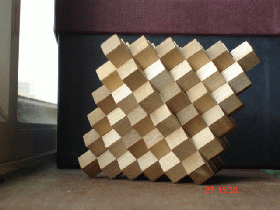 Last month I had a puzzle-buying holiday in Prague, and bought what is probably my heaviest puzzles so far, a 173 piece crystal burr, or pagoda burr, which one day I would like to fully dismantle and reassemble. I am therefore currently practising on much smaller versions, which is why I have this puzzle in my bag at present.
Last month I had a puzzle-buying holiday in Prague, and bought what is probably my heaviest puzzles so far, a 173 piece crystal burr, or pagoda burr, which one day I would like to fully dismantle and reassemble. I am therefore currently practising on much smaller versions, which is why I have this puzzle in my bag at present. 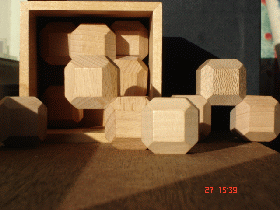 Last week we were discussing the puzzle consisting of four or five pieces made of connected spheres, which must be packed into a cubic wooden box. I mentioned that I had a version comprised of truncated and bevelled cubes rather than spheres, so I took this along with me on Friday night. Fortunately I had seen it at the front of a clear-fronted storage box.
Last week we were discussing the puzzle consisting of four or five pieces made of connected spheres, which must be packed into a cubic wooden box. I mentioned that I had a version comprised of truncated and bevelled cubes rather than spheres, so I took this along with me on Friday night. Fortunately I had seen it at the front of a clear-fronted storage box. 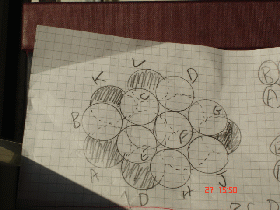
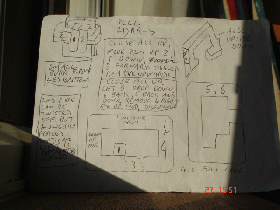
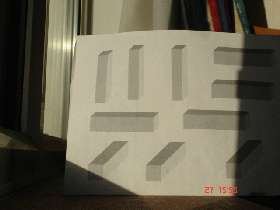
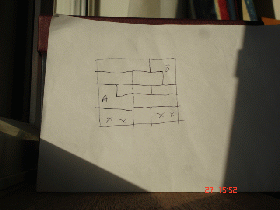
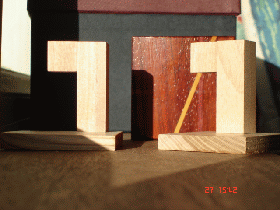 In the same box I found this interesting Cube Assembly, created by gluing tetracubes onto each of the six seperate faces of a box. A little arithmetic will tell you that only 24 of the 27 cubes in the three by three by three cube are present, but it is nevertheless a pleasing puzzle, a little infuriating but not too difficult.
In the same box I found this interesting Cube Assembly, created by gluing tetracubes onto each of the six seperate faces of a box. A little arithmetic will tell you that only 24 of the 27 cubes in the three by three by three cube are present, but it is nevertheless a pleasing puzzle, a little infuriating but not too difficult. 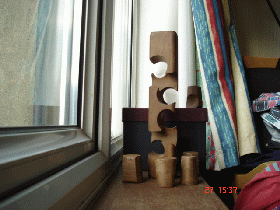
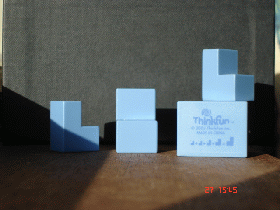 These four simple plastic pieces, resembling chairs are a recent new puzzle from Think Fun, formerly Binary Arts. The object is to assemble the four chairs into a giant size replica of one of them. A simple idea that makes a challenging puzzle!
These four simple plastic pieces, resembling chairs are a recent new puzzle from Think Fun, formerly Binary Arts. The object is to assemble the four chairs into a giant size replica of one of them. A simple idea that makes a challenging puzzle! 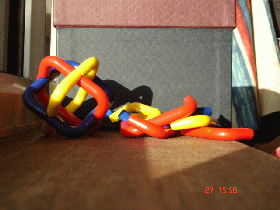
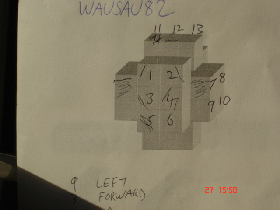
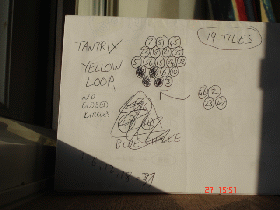
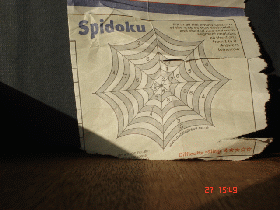
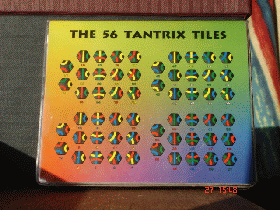
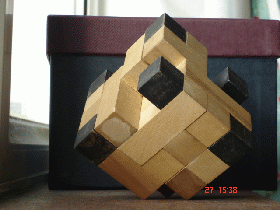
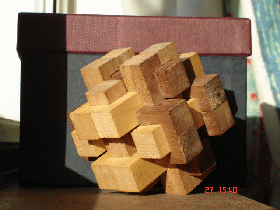
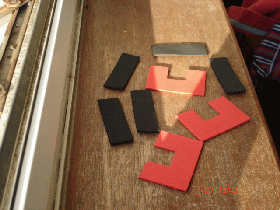 This is a surprisingly difficult puzzle called Cover Up, simultaneously designed by my friend Robert Reid and others, the object being to arrange the three U pentominoes in such a position that they can be covered with the five black straight trominoes. it's a wonderfully annoying puzzle, and I carry it with me frequently, out of respect for my wonderfully annoying friend Robert.
This is a surprisingly difficult puzzle called Cover Up, simultaneously designed by my friend Robert Reid and others, the object being to arrange the three U pentominoes in such a position that they can be covered with the five black straight trominoes. it's a wonderfully annoying puzzle, and I carry it with me frequently, out of respect for my wonderfully annoying friend Robert. 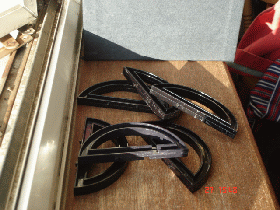
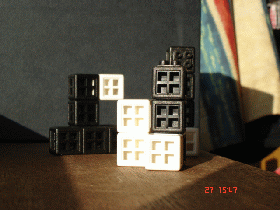
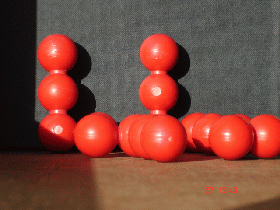
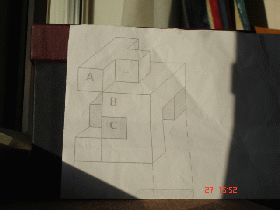
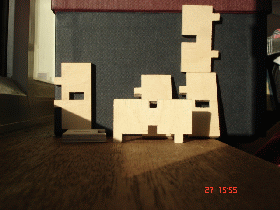
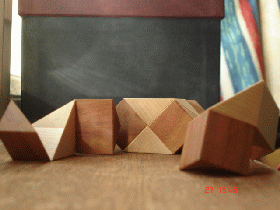
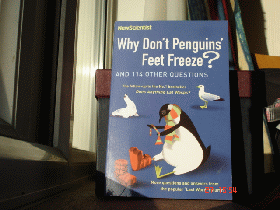 Not exactly puzzle-related, but none the less a wonderful addition to my puzzle bag at present, a Christmas gift from my Friday night cohort, Fred.
Not exactly puzzle-related, but none the less a wonderful addition to my puzzle bag at present, a Christmas gift from my Friday night cohort, Fred.